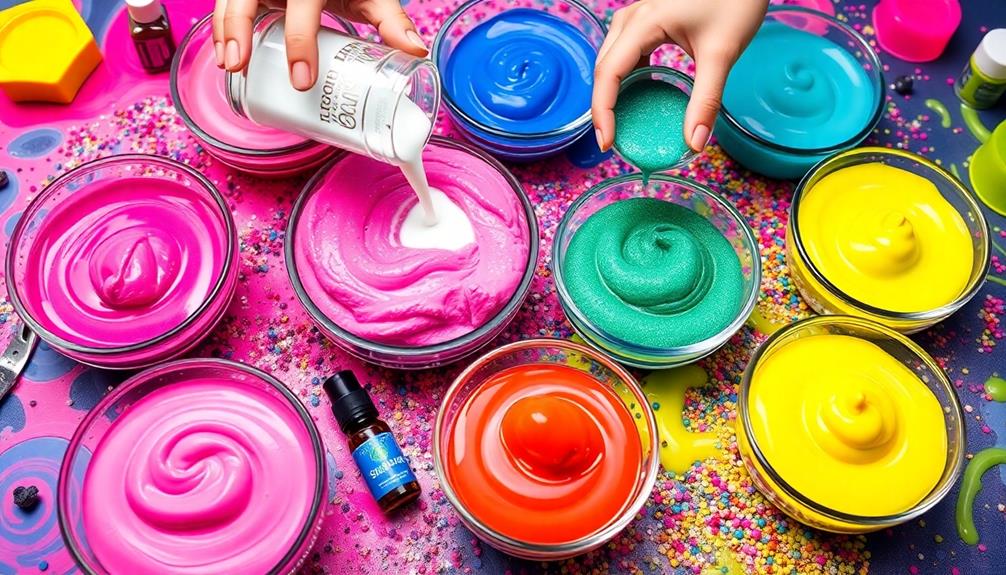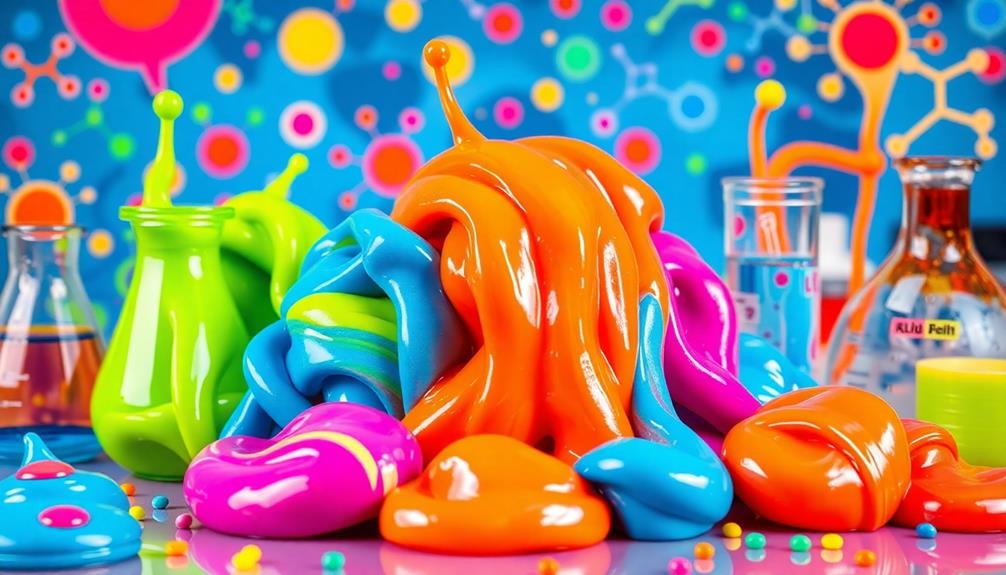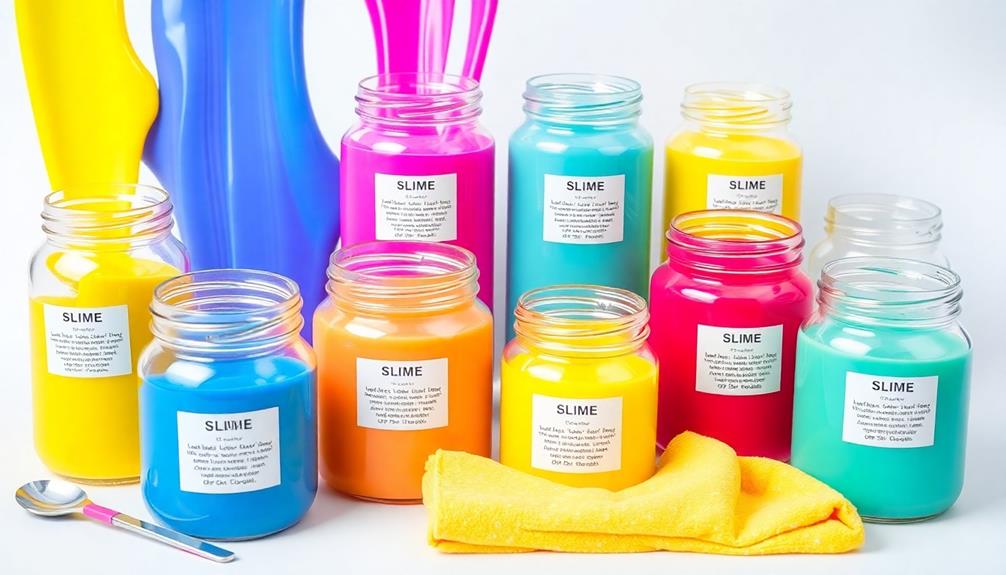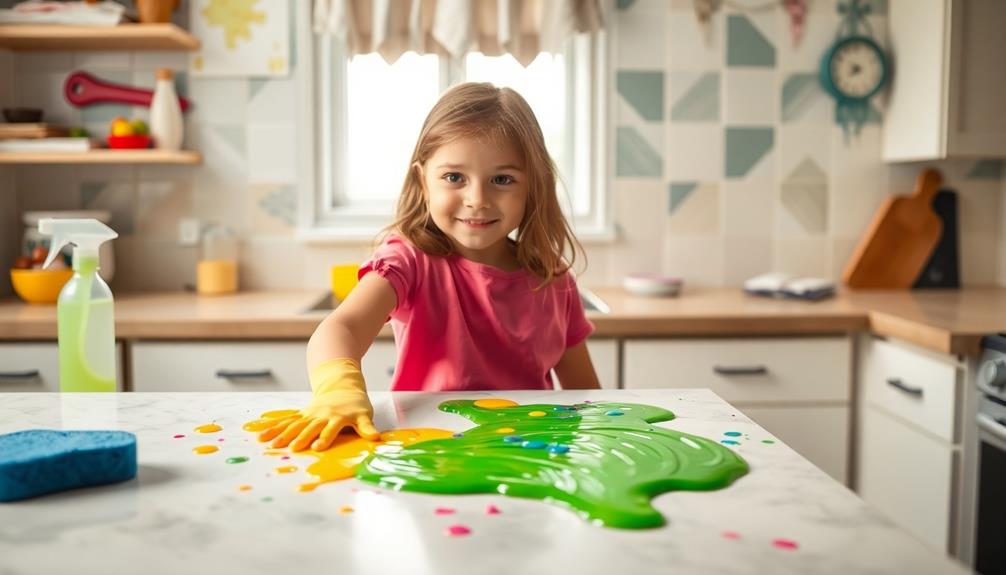Making slime at home is super easy and a lot of fun! You'll need basic ingredients like glue and an activator, such as borax or liquid starch. Start with a classic recipe: mix 4 oz of glue with 1/2 cup of water, then add your activator. Experiment with colors, scents, or add-ins like glitter for a personal touch. Remember to store your slime in an airtight container to keep it fresh. If you run into issues with stickiness or hardness, there's a quick fix. Keep exploring different recipes and tips, and you'll soon be a slime-making pro!
Key Takeaways
- Gather essential ingredients: glue, activator (like borax or liquid starch), and optional enhancements like baking soda and food coloring.
- Follow basic slime recipes, such as mixing 4 oz of glue with 1/2 cup of water and your chosen activator.
- Customize your slime by adding colors, glitter, or scents for a unique touch and aesthetic appeal.
- Store slime in airtight containers at room temperature to maintain freshness and texture consistency.
- Regularly knead slime and use warm water or glue to soften hardened slime without refrigeration.
Overview of Slime Making

Making slime is a fun and interactive activity that anyone can enjoy, regardless of age. When you decide to make slime, you're not just having fun; you're engaging in a delightful science experiment. The basic ingredients you'll need are glue and an activator. Common activators include borax, liquid starch, and laundry detergent. These components work together to create that satisfying, stretchy slime you love.
There are countless recipes available online, each offering unique twists on traditional slime. You can customize your slime experience by experimenting with different colors, textures, and even scents. This flexibility allows you to tap into your creativity and make something truly your own.
As you begin your slime-making journey, don't hesitate to share your experiences with others. The slime-making community thrives on shared tips and feedback, making it a collaborative adventure.
Plus, there are plenty of printable recipe guides and video tutorials out there to help you get started, especially if you're a visual learner. So gather your ingredients, roll up your sleeves, and plunge into the wonderful world of slime making!
Essential Ingredients for Slime

To make slime, you need a few essential ingredients that form the base of your creation.
The main components are glue and an activator, but there are also alternative options you can explore for different textures.
Let's break down these common slime ingredients and their variations to help you get started.
Common Slime Ingredients
Slime creation hinges on a few essential ingredients that guarantee the perfect texture and consistency. The primary component is glue, typically PVA or white school glue, which forms the base of your slime.
Next, you'll need an activator to transform the glue into that satisfying, stretchy substance. Common activators include borax solution, liquid starch, and contact lens solution, each offering unique slime textures.
For a basic recipe, mix 4 oz of glue with 1/2 cup of water, then activate it using a borax solution made from 1/2 teaspoon of borax dissolved in 1/2 cup of hot water.
If you prefer a borax-free option, simply combine 4 oz of glue with 1/4 cup of liquid starch.
You can also enhance your slime with baking soda, which helps with adhesion and thickness.
To add a personal touch, incorporate food coloring to make your slime more visually appealing.
With these common slime ingredients, you're well on your way to creating the perfect gooey masterpiece that's both fun to make and play with!
Activators for Slime Creation
Activators play a pivotal role in transforming your glue mixture into the stretchy, fun substance you want. The most common activators include borax, liquid starch, and a combination of baking soda with contact solution. Each offers unique textures and properties for your slime.
When you use borax, dissolve it in hot water to create a solution that effectively crosslinks the polymers in your glue mixture. This results in a stretchy and firm slime that many love.
On the other hand, liquid starch is a safer alternative, yielding a smooth, less sticky slime that's perfect for those avoiding traditional activators.
If you're looking for a simple option, mixing baking soda with contact solution is a great choice. This combination creates a softer texture that's easier to manipulate, making it ideal for younger slime makers.
Remember to add your chosen activator slowly to the glue mixture. This careful approach helps you reach your desired consistency without over-activating, which can lead to firm and less pliable slime.
Experimenting with these activators will help you discover the perfect slime for your needs!
Alternative Ingredients Options
While traditional slime recipes often rely on glue and activators, there are plenty of alternative ingredients that can lead to equally exciting results.
If you want to make homemade slime recipes without borax, consider using baking soda combined with contact lens solution. This combination creates a pliable texture that's both safe and fun.
For a unique twist, you can add 1/2 cup of conditioner mixed with cornstarch to create a glue-free slime. This mixture provides a completely different texture that's interesting to play with.
If you're aiming for clear slime, opt for clear school glue activated with either a borax solution or liquid starch. The result is a transparent slime that's visually stunning.
You can also experiment by adding different ingredients like shaving cream to transform your regular slime into fluffy slime. This not only enhances the texture but also increases the volume, making it more enjoyable to squish and stretch.
Classic and Alternative Recipes

When it comes to making slime, you have a variety of classic and alternative recipes to choose from. Here are a few options to get you started:
- Classic slime recipe: Combine 4 oz of white school glue, 1/2 cup of water, and a borax solution (1/2 teaspoon of borax dissolved in 1/2 cup of hot water) for that stretchy consistency.
- Alternative borax-free slime recipe: Use 4 oz of school glue and 1/4 cup of liquid starch for a simpler, borax-free option.
- Fluffy slime: For a light and airy texture, mix in 1 cup of shaving cream and 1 teaspoon of hand lotion to your basic slime mixture.
- Clear slime: Achieve a transparent look by combining 4 oz of clear school glue with 1/2 cup of water, then activating it with either a borax solution or liquid starch.
Feel free to experiment with these recipes using everyday household ingredients. Each provides a unique texture and experience, perfect for your next slime experiments.
Enjoy crafting your slime creations!
Customizing Your Slime

Customizing your slime opens up a world of creativity and fun. You can easily transform your favorite slime into something truly unique by adding various elements. Start by using a mixing bowl to combine your base slime with food coloring. Vary the intensity to create customized colors, or even experiment with layering for a marbled effect.
Consider adding glitter, which enhances the visual appeal, making your slime sparkle and shine. For an extra sensory experience, mix in cut-up rubber bands or foam balls for a fun texture contrast. You could also use craft paints to achieve specific colors that match your favorite themes or characters.
Don't forget about scent! Adding essential oils or extracts not only personalizes your slime but also gives it a delightful aroma. Here's a quick reference table for your customization options:
| Customization Option | Description |
|---|---|
| Add Food Coloring | Create customized colors |
| Add Glitter | Enhance visual appeal with sparkle |
| Essential Oils | Personalize with delightful scents |
With these tips, your slime will truly reflect your personality and creativity!
Tips for Successful Slime

For the best slime-making experience, you'll want to follow a few essential tips that guarantee success.
These simple guidelines will help you create the perfect fun slime every time!
- Use travel-sized contact lens solution for a cost-effective activator.
- Protect your surfaces with an oilcloth to guarantee easy cleanup.
- Always wash your hands before and after making slime to maintain hygiene.
- Store extra slime in an airtight container to keep it fresh longer.
When you're making slime, it's vital to experiment with different ingredient ratios.
For instance, adding less contact solution will yield a stickier slime, while incorporating shaving foam can give you that fluffy texture you crave.
After you're done, remember to soak your tools and containers in warm soapy water immediately.
This prevents the glue from hardening and makes cleanup a breeze.
With these tips, you'll be on your way to mastering an easy slime recipe that's both enjoyable and mess-free.
Happy slime-making!
Science Behind Slime

Slime is a fascinating substance that captivates both kids and adults alike, thanks to its unique properties. The science behind slime revolves around its classification as a non-Newtonian fluid, which means its viscosity changes under stress. This allows slime to act like both a solid and a liquid, depending on how you handle it.
The key to making slime lies in polymer crosslinking. When you combine polyvinyl acetate, the main ingredient in school glue, with an activator like borax, the molecules bond to form a flexible and stretchy network. This process traps water, resulting in that iconic slime texture we all love.
You'll notice that different slime recipes yield various textures based on the ratios of ingredients and types of polymers used. For instance, adding shaving cream can create a fluffy slime that's delightfully different from the classic version.
Exploring the properties of slime can enhance your experimentation with different additives and ratios, allowing you to create unique textures and colors. So, immerse yourself in the science behind slime and discover the endless possibilities!
Slime Care and Maintenance

To keep your slime in top shape, store it in an airtight container or zip bag when you're not playing with it.
Make sure to knead it regularly to maintain its texture and keep it from getting too sticky or hard.
If it does harden, you can easily revive it by mixing in warm water, glue, or lotion.
Proper Storage Techniques
How can you keep your slime fresh and stretchy? Proper storage is key! By following these simple techniques, you can enjoy your slime for a longer time.
- Store slime in an airtight container or plastic zip bag.
- Avoid refrigeration, as cold temperatures can harden your slime.
- Seal it after use to prevent excess exposure to air.
- Knead slime regularly to maintain its texture.
To prevent it from drying out, always guarantee you seal your slime immediately after playing with it.
If you notice it starting to harden, you can work on softening hard slime by adding warm water, more glue, or lotion.
Knead it until you achieve the desired consistency—this will help keep your slime pliable and fun to play with.
Maintaining Texture Consistency
Maintaining the right texture consistency in your slime is essential for keeping it fun and enjoyable. To guarantee your slime without glue remains playful, store it in an airtight container at room temperature. Avoid refrigeration, as cold temperatures can harden your slime, making it less pliable.
Regularly kneading your slime during storage can help maintain its stretchy texture, preventing it from becoming sticky or hard. If your slime becomes too wet or sticky, gradually add more contact solution while kneading to restore the right texture.
Here's a quick reference table for texture consistency:
| Condition | Solution | Notes |
|---|---|---|
| Too Sticky | Add more contact solution | Knead until desired consistency |
| Too Hard | Add warm water or more glue | Knead until pliable |
| Just Right | Keep it stored properly | Regularly knead for maintenance |
Softening Hard Slime
If your slime has turned hard and unplayable, don't worry—softening it's simple and effective. Follow these easy steps to bring your slime back to life:
- Add a small amount of warm water to your hard slime.
- Knead it thoroughly until you achieve the desired consistency.
- If it's still too stiff, consider incorporating more glue or a few drops of lotion.
- Store it in an airtight container immediately after use to prevent future hardening.
Excessive exposure to air is one of the main culprits behind hard slime. To prevent this, always keep your slime sealed when you're not playing with it.
Kneading your slime periodically can also help maintain its soft and stretchy characteristics, making it more enjoyable to play with.
Remember, refrigerating slime isn't a good idea; cold temperatures can lead to hardening and loss of elasticity.
Cleanup and Removal Techniques

Cleaning up slime can be a hassle, but quick action makes a world of difference. When you notice a mess, it's vital to tackle it promptly to avoid tough stains or residue.
If slime lands on clothing, mix vinegar and warm water, then gently apply it to the stain before rinsing thoroughly.
Should slime get stuck in hair, don't panic! Warm water combined with shampoo or a bit of cooking oil can work wonders. Just apply it carefully and work it through the affected area.
For carpets, grab a soft-bristled brush and scrub a solution of warm water and vinegar into the stain. This technique helps lift the slime from the fibers effectively.
To prevent further mess, always dispose of any leftover slime in a plastic bag before throwing it in the trash. This guarantees safe disposal and minimizes the risk of more stains.
Frequently Asked Questions
How Do You Make Perfect Slime at Home?
To make perfect slime at home, mix 4 oz of white glue with 1/2 cup water, then slowly add a borax solution while stirring. Customize with colors or glitter, and store it in an airtight container.
What Is the Secret to Making Slime?
The secret to making slime lies in the chemical reaction between glue and an activator. You'll need the right ratios, and experimenting with different ingredients can help you create unique textures and colorful variations.
How Do You Make 3 Ingredient Slime?
You're in luck! Making 3-ingredient slime is super easy. Combine glue and baking soda, then stir in contact lens solution until it forms. Add color or glitter if you want, and knead until perfect!
How Do You Make Ultimate Fluffy Slime?
To make ultimate fluffy slime, combine white school glue, liquid starch, and shaving cream. Add food coloring for vibrancy, knead until fluffy, and store in an airtight container to keep it fresh and stretchy. Enjoy!
Conclusion
Now that you're equipped with all the know-how to create your very own slime, let your imagination run wild! Each squish and stretch offers a little escape from the everyday, transforming simple ingredients into gooey masterpieces. Remember, the joy of slime-making isn't just in the final product, but in the delightful mess along the way. So, embrace the whimsy, cherish the moments, and let your vibrant creations bring a smile to your face! Happy sliming!










